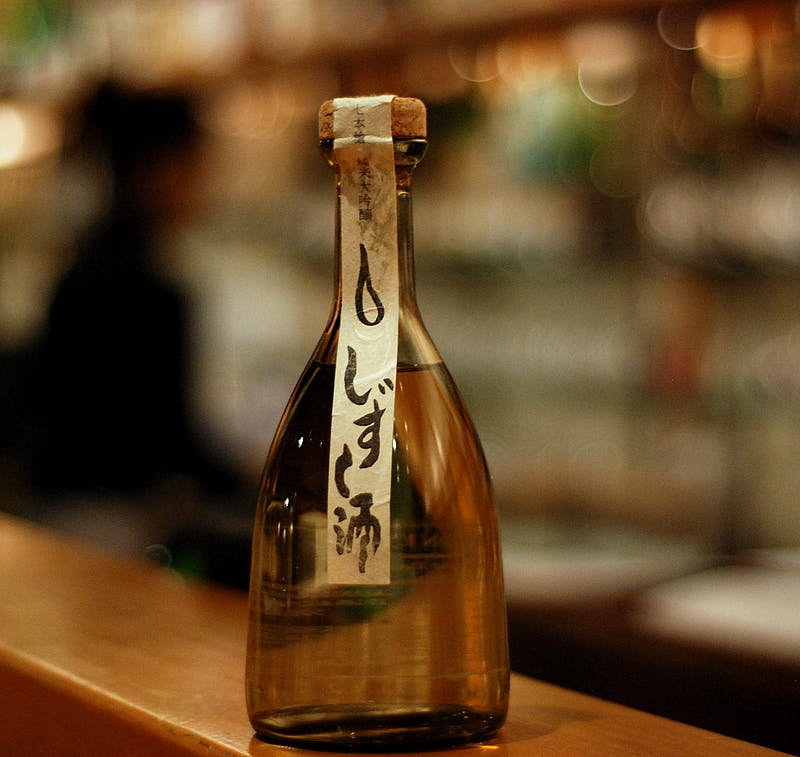
old school sake
Learn about a visit with a 15th generation brewer of regional sake at a New York restaurant. Discover the unique brewing technique, regional cooking pairings, and flavors of different sake types, including futsushu and shizuku, while also understanding the significance of Tamazakae rice in the process.
I've been trying to learn more about sake, so when my friend Henry Sidel, the owner of importer Joto Sake, invited me to raise a glass of nihonshu with a 15th generation brewer visiting New York, I was on my way.
I met Henry and the brewer, Mr. Yasunobu Tomita, for lunch at Sakagura, one of my favorite Japanese joints in the city. The restaurant's manager, Hisaya Kadoi, also joined us for soba, sake and a bit of shop talk, complete with samples of sake rice in sandwich-size baggies.
Tomita-san's brewery, the eponymous Tomita Shuzo, is one of the oldest -- and smallest -- breweries in Japan. Founded in the 1540s, only a brewmaster and two assistants produce every bottle. Tomita-san whipped out a stack of photos from his bag to show us how he brews his sake traditionally, by hand and only in the winter, the customary time to make sake -- the cold weather helps control the fermentation process.
Tomita Sakagura is located in the small town of Kinomoto, in central Japan not far from Kyoto, and along the banks of Lake Biwa . I've been interested in the idea of regional sakes, and was curious to know how this sake complemented the local cooking in his area.
Tomita-san was a gracious man in his mid 30's who taught himself English by listening to tapes in his car driving to work. He started by explaining -- hold on, we're going to get sake technical here -- the difference between meshoshu and futsushu sake. Come again? Most of the sake we taste in America is the fancy stuff, the ginjo and daiginjo. That's called "meshoshu." But nine out of ten bottles of sake produced in Japan are a more humble brew, called "futsushu," like the sake version of house wine.
Tomita-san explained that he sells 80% of his sake in his local area, most of which is futsushu. The rest, the higher-end stuff, goes to the big cities and abroad.
So what about that futsushu?
"I imagine it would go well with the local cooking," The manager Kadoi-san ventured.
What kind of cooking?
"Since we're right next to Lake Biwa," Tomita-san explained, "we eat a lot of freshwater fish." He described a signature dish: Ayu (sweetfish) braised in a mixture of miso, sugar and soy sauce for hours until the bones are soft enough to eat. Sounded rustic, simple but flavorful, my kind of Japanese cooking.
"Our futsushu sake tastes really good with that dish," Tomita-san assured us.
As our own dishes arrived -- soba served cold on this hot summer day -- we began to sample Tomita-san's different sakes. Like wine, sake tastes best when it's paired with food. Tomita-san's brews were fragrant and delicious, with a pleasant yeastiness to them. We worked our way to his finest sake, a junmai daiginjo (check out sake expert John Gauntner's website to find out what this means), presented in a simple but beautiful glass bottle with a cork stopper. (That's bottle in the photo above.)
Now Henry stepped in to explain.
"This style of sake is called shizuku sake," he said, adding that shizuku means "drops" in Japanese. A canvas bladder -- which from Tomita-san's photos resembles a two-foot long water balloon -- is filled with unfiltered sake and suspended by a rope. Pure daiginjo sake sweats out of the canvas and drips into a catch basin, drop, drop, drop, drop. This is a slow, painstaking process -- and shizuku sakes are very pricey as a result.
"Shizuku as a style is the most delicate kind of sake made," Henry explained. "It's very, very light and subtle, almost like water."
But Tomita-san's version was different, I thought. It had real presence, even to my untrained palette.
"That's because Tomita-san makes his with local Tamazakae rice, which is very unusual," Henry said. This earthy, artisanal rice gives the sake musky and herbal flavors.
When Tomita-san heard Henry mention Tamazakae, he went to his satchel and pulled out a few of the sandwich-sized baggies, each filled with rice.
"This is Tamazakae," he said as he handed me a baggie to check out.
A local farmer grows this rice especially for him -- and then comes to work in the brewery to make sake in the winter when his fields are fallow. And here's something else Tomita-san shared with us:
Each spring he invites friends of the brewery to come to the farm to help plant the rice, which can only be done by hand. Some 200 volunteers converge from as far away as Tokyo. Their reward? A "drinking and eating" party at the edge of the rice field when the planting is finished!
Guess where I'm heading next spring.
